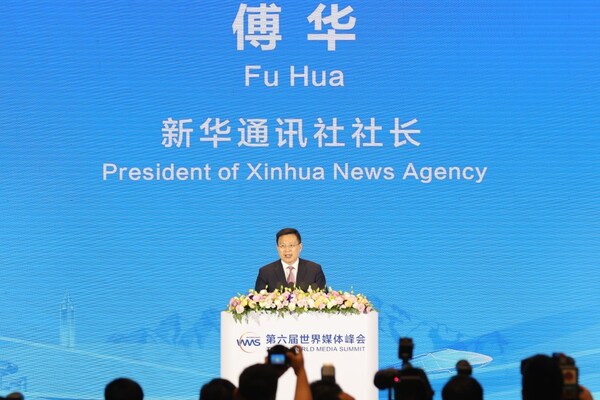URUMQI, China, Oct. 15, 2024 /PRNewswire/ -- At a time when the world is increasingly influenced by artificial intelligence (AI), media leaders from around the globe gathered in the vibrant heart of northwest China's Xinjiang on Monday to discuss the opportunities and challenges brought about by AI.
As the 6th World Media Summit unfolds in Urumqi, capital city of Xinjiang Uygur Autonomous Region, more than 500 attendees from over 106 countries and regions discussed topics under the theme "AI and Media Transformation."
Representatives from 208 institutions, including media outlets, government agencies and international organizations, engaged in discussions highlighting the transformative impact of AI on the global media industry. They examined the media's evolving role and responsibilities amid this technological revolution.
The summit released a joint statement emphasizing the importance of rationally adopting AI technologies while upholding journalistic ethics and professional standards.
The statement called for enhanced collaboration within the global media sector to share advancements in AI development, thereby facilitating high-quality development worldwide.
"We should proactively align with the technological wave, closely track the advancement of AI, particularly generative technologies like ChatGPT and Sora, and seize every opportunity for media innovation," Fu Hua, president of Xinhua News Agency, said in his keynote address.
Media leaders underscored the importance of innovation fueled by AI, a viewpoint reflected in the findings of a global survey conducted by Xinhua Institute, a think tank under Xinhua. The survey is part of a think tank report titled "Responsibility and Mission of News Media in AI Era," which was unveiled at Monday's event.
The survey reveals that over half of the interviewed media organizations have already incorporated generative AI into their operations.
According to the report, technologies such as algorithmic recommendations, voice interaction, and image generation are increasingly being applied across various stages of news collection, production, distribution, reception, and feedback.
Describing opportunities and challenges that AI brings to media development as "enormous, even disruptive," Fu underlined the importance of "humans having the final say in human-machine interaction."
"We should move beyond 'tech-centric thinking' and effectively leverage the initiative of editors and reporters," he said.
Speaking at the summit, Andrey Kondrashov, director general of Russian news agency TASS, said that AI serves merely as a tool. Media's primary responsibility -- creating high-quality content that is authentic, trustworthy, and meaningful -- still rests with people, Kondrashov said.
Media executives warned of significant risks and challenges brought by AI, such as fake news, filter bubbles, deepfakes, and privacy theft.
According to the survey unveiled in the think tank report, nearly 30 percent of the interviewed media outlets expressed uncertainty regarding whether the benefits of generative AI outweigh its drawbacks.
A notable 76.4 percent of the respondents voiced concerns about potential "distortion and misalignment of news leads and materials," and 61.1 percent expressed worries about "copyright and liability issues."
Gan Ling-Sze, vice president of Reuters News Agency Asia Pacific, said that the advancement of generative AI will bring an increased risk for well-produced misinformation and disinformation. "In a world where there is so much content, the need for trusted sources of news, robust fact-checking and transparency will only grow."
At a recent high-level meeting in Beijing, senior officials of four major global wire services -- Xinhua, Reuters, The Associated Press (AP), and Agence France-Presse -- noted that news agencies should actively harness AI to empower journalism while building guardrails to mitigate risks. They said the media should adhere to journalistic standards and stay committed to providing audiences with credible, accurate and objective news.
Fu said Xinhua is willing to work with media peers to establish a transnational, cross-regional AI media lab. He emphasized the importance of enhancing AI-related experience and achievement sharing to help bridge the "digital divide," calling on global media to set professional standards to maintain journalistic ethics in the AI era.
MULTI-DIMENSIONAL VIEW OF XINJIANG
This year's summit is jointly organized by Xinhua and the Xinjiang regional government.
As the global media community gathered for the summit to discuss safeguarding the core values of journalism -- objectivity and truth -- they were offered a valuable opportunity to gain firsthand insights into Xinjiang.
Mary Schiavo, an aviation analyst for an international media outlet, said that Xinjiang parallels what is going on in AI -- people don't know too much about it, but they've heard a lot. "It's highly significant for the summit to be held in Xinjiang. By coming here, seeing Xinjiang yourself is really enlightening."
"As we gather at this summit today, we have the opportunity to strengthen the credibility of information as we confront disinformation, misinformation, and hate speech," said Siddharth Chatterjee, United Nations development system resident coordinator in China.
In his speech, Ma Xingrui, secretary of the Xinjiang regional committee of the Communist Party of China, described the summit as a great opportunity for journalists to gain firsthand experience of Xinjiang.
Boasting a diverse cultural tapestry, Xinjiang, with about one-sixth of China's territory, has demonstrated robust economic growth in recent years. In 2023, it ranked among the top five provincial-level regions nationwide across six major indicators including GDP growth, investment levels, consumption rates, and income of residents.
Located at the heart of the Silk Road Economic Belt, Xinjiang is becoming increasingly vital as a hub connecting Asia and Europe while serving as a key gateway for China's westward opening up.
Established in late 2023, the China (Xinjiang) Pilot Free Trade Zone, which comprises three iconic areas in Urumqi, Kashgar, and Horgos, and the region's integrated bonded areas have become important engines driving Xinjiang's foreign trade.
According to Guo Shusong, an official of the management committee of the comprehensive bonded zone in Kashgar, the region's foreign trade volume is expected to reach 100 billion yuan (about 14 billion U.S. dollars) this year. "As a vanguard of China's westward opening up, it is highly anticipated that the foreign trade volume here will even reach 1 trillion yuan one day."
"I am excited to visit Xinjiang, a region that epitomizes advanced open development. This area represents a harmonious blend of tradition and technological innovation. I am optimistic that through collaborative learning, we can achieve remarkable successes together," said Tamas Kovacs, CEO of Hungary's ATV Media Group.
As Xinjiang enters its best period of high-quality development in history, the summit is in the nick of time to better tell the story of a real, vibrant, and beautiful Xinjiang.
The high-quality development and high-level opening up of Xinjiang are inseparable from sincere communication, mutual trust, and practical cooperation, said Erkin Tuniyaz, chairman of the regional government of Xinjiang.
"We invite media friends to come to Xinjiang on reporting or sightseeing trips, and share the true stories of the region with the world," Tuniyaz said.












